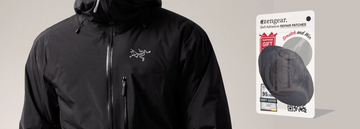So flicken Sie ein Loch in einem Zelt mit Reparaturflicken: Eine Schritt-für-Schritt-Anleitung
von {{ author }} Emily Jannet an Sep 16, 2024
Beim Camping ist es wunderbar, die Natur zu erleben, aber nichts kann Ihr Abenteuer schneller ruinieren, als ein Loch in Ihrem Zelt. Ein kleiner Riss oder ein Loch kann Ihren Unterschlupf gefährden und Wind, Regen, Insekten oder sogar kalte Luft eindringen lassen. Glücklicherweise ist das Reparieren eines Lochs in Ihrem Zelt ein unkomplizierter Vorgang, insbesondere wenn Sie ein Zeltreparaturset haben. In dieser Anleitung erklären wir Ihnen alles, was Sie über das Flicken eines Lochs in Ihrem Zelt wissen müssen, damit es für Ihr nächstes Outdoor-Abenteuer bereit ist.
Warum sollten Sie Ihr Zelt reparieren?
Ihr Zelt ist eines der wichtigsten Teile Ihrer Campingausrüstung. Es bietet Schutz vor den Elementen und einen bequemen Platz zum Ausruhen. Selbst kleinere Schäden können sich schnell ausbreiten und zu größeren Rissen oder Brüchen führen, die schwieriger zu reparieren sind. Indem Sie alle Löcher umgehend reparieren, können Sie die Lebensdauer Ihres Zelts verlängern, seine Wasserdichtigkeit aufrechterhalten und auf lange Sicht Geld sparen.
Was du brauchen wirst
Um ein Loch in Ihrem Zelt effektiv zu flicken, benötigen Sie einige grundlegende Dinge. Die meisten davon sind in einem Standard-Zeltreparaturset enthalten, Sie können sie aber auch separat erwerben:
- Zeltreparatur-Flickenset : Diese Sets enthalten normalerweise Klebeflicken, die speziell für die Reparatur von Stoffen entwickelt wurden.
- Reinigungsalkohol oder Reinigungslösung : Wird verwendet, um den Bereich um das Loch zu reinigen und so die ordnungsgemäße Haftung des Flickens sicherzustellen.
- Schere : Um den Flicken auf die richtige Größe und Form zuzuschneiden.
- Nahtversiegelung (optional): Zum Abdichten der Kanten des Flickens und Sicherstellen einer dichten Versiegelung gegen Feuchtigkeit.
Schritt-für-Schritt-Anleitung zum Ausbessern eines Zeltlochs
-
Identifizieren Sie den Schaden : Suchen Sie zunächst alle Löcher oder Risse in Ihrem Zelt. Untersuchen Sie das Äußere und Innere sorgfältig, insbesondere stark beanspruchte Bereiche wie Reißverschlüsse, Nähte und Ecken. Notieren Sie alle Bereiche, die repariert werden müssen.
-
Reinigen Sie den Bereich : Reinigen Sie den Bereich um das Loch mit Reinigungsalkohol oder einer milden Reinigungslösung. Schmutz, Staub und Öle können dazu führen, dass der Flicken nicht richtig haftet. Stellen Sie daher sicher, dass der Stoff sauber und trocken ist, bevor Sie fortfahren. Vermeiden Sie die Verwendung scharfer Reinigungsmittel, die den Zeltstoff beschädigen könnten.
-
Schneiden Sie den Flicken auf die richtige Größe : Nehmen Sie einen der Klebeflicken aus Ihrem Reparaturset und schneiden Sie ihn auf die richtige Größe zu. Der Flicken sollte an allen Seiten mindestens 2,5 cm größer sein als das Loch, um einen sicheren Sitz zu gewährleisten. Runden Sie die Ecken des Flickens ab, um ein Ablösen zu verhindern, da scharfe Ecken leichter hängen bleiben und sich ablösen.
-
Bringen Sie den Flicken an : Legen Sie den Flicken vorsichtig über das Loch und drücken Sie ihn fest an, damit er haftet. Beginnen Sie in der Mitte und arbeiten Sie sich nach außen vor, wobei Sie alle Blasen oder Falten glätten. Einige Reparaturflicken sind für die Anwendung im Zeltinneren gedacht, während andere auf der Außenseite angebracht werden. Lesen Sie in der Anleitung Ihres Flickzeugs nach, wo Sie den Flicken am besten anbringen.
-
Drücken und versiegeln : Verwenden Sie einen flachen Gegenstand wie eine Kreditkarte, um den Flicken nach unten zu drücken und alle Luftblasen zu entfernen, damit der Flicken vollständig mit dem Zeltstoff in Kontakt kommt. Durch festes Drücken für einige Minuten wird der Klebstoff aktiviert und die Verbindung wird gestärkt.
-
Optional: Verwenden Sie Nahtversiegelung : Um die Reparatur noch wasserdichter zu machen, tragen Sie eine dünne Schicht Nahtversiegelung um die Ränder des Flickens auf. Dieser Schritt ist besonders nützlich, wenn sich das Loch in der Nähe einer Naht befindet oder wenn Sie bei nassen Bedingungen campen. Lassen Sie die Versiegelung vollständig trocknen, bevor Sie Ihr Zelt einpacken.
-
Testen Sie die Reparatur : Sobald der Flicken sicher sitzt und das Dichtungsmittel getrocknet ist, bauen Sie Ihr Zelt auf und überprüfen Sie die Reparatur. Drücken Sie vorsichtig um den Flicken herum, um sicherzustellen, dass er vollständig haftet. Wenn Sie sich Sorgen um die Wasserdichtigkeit machen, testen Sie ihn mit einem leichten Wasserstrahl, um zu sehen, ob Feuchtigkeit durchsickert.
Weitere Tipps zur Zeltreparatur
-
Wählen Sie den richtigen Flicken : Die meisten Reparatursets enthalten Flicken aus strapazierfähigen, wasserdichten Materialien wie Nylon oder Polyester. Verwenden Sie für die Netzbereiche Ihres Zelts Netzreparaturflicken oder ziehen Sie Nähen und anschließend Nahtversiegelung in Betracht.
-
Halten Sie ein Reparaturset griffbereit : Ein kleines Reparaturset sollte Teil Ihrer Standard-Campingausrüstung sein. Flicken, Nahtversiegler und sogar eine kleine Tube Zeltkleber können Ihre Reise retten, wenn Sie auf unerwartete Schäden stoßen.
-
Reparieren Sie größere Risse zuerst mit Klebeband : Verwenden Sie bei größeren Rissen Reparaturklebeband als Unterlage, bevor Sie den Flicken auftragen. Dies bietet zusätzlichen Halt und hilft, den Stoff zusammenzuhalten, während der Flicken fest wird.
-
Regelmäßige Wartung : Überprüfen Sie Ihr Zelt regelmäßig auf Anzeichen von Abnutzung. Um die Lebensdauer Ihres Zelts zu verlängern, sollten Sie sich um kleine Probleme kümmern, bevor sie zu großen werden.
Hier können Sie auch lesen , wie Sie Ihren Wanderrucksack mithilfe von Zengear-Reparaturflicken reparieren .
Ein Loch in Ihrem Zelt zu flicken ist eine einfache, aber grundlegende Fähigkeit, die jeder Camper beherrschen sollte. Mit den richtigen Werkzeugen und ein wenig Know-how können Sie Ihr Zelt schnell und effektiv reparieren und sicherstellen, dass es Ihnen bei all Ihren Outdoor-Abenteuern ein zuverlässiger Unterschlupf bleibt. Lassen Sie sich Ihren Ausflug also nicht durch einen kleinen Riss verderben – seien Sie vorbereitet, handeln Sie schnell und halten Sie Ihr Zelt jahrelang in gutem Zustand.





